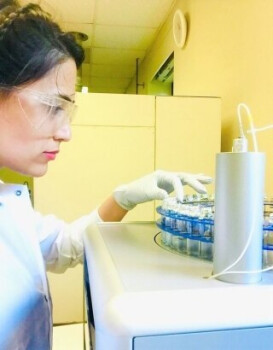PhD - Soil Sciences
University of Delaware - 2022

Layla Izadi
Research Scientist - Geosciences
The Environmental Soil Biogeochemistry Laboratory (ESB Lab) focuses on how climate-change-related stressors such as sea-level rise, salt-water flooding, drought, and wildfire impact the cycling and speciation of toxic metals and nutrients.
ECSW 2.355A
The Environmental Soil Biogeochemistry Lab
Google Scholar
ORCID
Currently accepting undergraduate and graduate students
Professional Preparation
MCE - Civil Engineering
University of Delaware - 2021
University of Delaware - 2021
Research Areas
Environmental Soil Chemistry
My research investigates the behavior of toxic metals such as arsenic (As), chromium (Cr), and lead (Pb), as well as essential nutrients like phosphorus (P), nitrogen (N), and sulfur (S) in soils. I explore how these elements are bound to soil particles under varying environmental and experimental conditions, including changes in pH, temperature, hydration state, microbial presence, and duration of exposure. Additionally, my work examines how different climatic factors, such as temperature fluctuations, moisture levels, and extreme weather events, influence the interactions and transformations of these metals and nutrients within the soil matrix.To achieve this, I utilize advanced analytical techniques, including bright light sources at synchrotron facilities, to determine the molecular forms (species) of these metals and nutrients in soils. This molecular-level understanding is crucial for accurately predicting how these contaminants might leach into groundwater or surface water, which in turn affects their toxicity and bioavailability to plants, animals, and humans. By understanding these processes, my research aims to contribute to the development of effective strategies for managing soil contamination and safeguarding environmental and public health.
Publications
Hurricanes and turbulent floods threaten arsenic-contaminated coastal soils and vulnerable communities 2025 - Journal Article
Multimodal, microspectroscopic speciation of legacy phosphorus in two US Mid‐Atlantic agricultural soils 2024 - Journal Article
Sea-level-rise-induced flooding drives arsenic release from coastal sediments 2022 - Journal Article
Estimating the chemical oxygen demand of petrochemical wastewater treatment plants using linear and nonlinear statistical models – A case study 2021 - Journal Article
Mathematical model for reactive transport of heavy metals in soil column: Based on PHREEQC and HP1 simulators 2017 - Journal Article
Air pollution study using factor analysis and univariate Box-Jenkins modeling for the northwest of Tehran 2015 - Journal Article
Awards
SPIRe Seed Grant - University of Texas at Dallas [2024]
Convergence Research (CORE) Institute Fellowship - CORE Institute [2023]
Engineering Postdoctoral Fellowship - NSF [2023]
Donald L. and Joy G. Sparks Fellowship - University of Delaware [2021]
DENIN Environmental Fellowship - University of Delaware [2020]
Presentations
Climate change and arsenic behavior in soils
2023/11 2023 ASA–CSSA–SSSA International Annual Meeting, St. Louis, MORising Seas Bring Dead Contaminants Back to Life!
2022/08 22nd World Congress of Soil Science, Glasgow, ScotlandImpacts of sea-level rise on the fate of arsenic in contaminated coasts
2022/03 ACS Spring 2022 Conference, San Diego, CAHow does Sea-level Rise Impact Pollution Release in Contaminated Coasts?
2021/11 2021 ASA-CSSA-SSSA International Annual Meeting, Salt Lake City, UTElemental cycling from contaminated coastal sediments subjected to varying SLR-induced flooding intensities
2021/04 ACS Spring 2021 Conference,News Articles
Researching heavy metals
 The Port of Wilmington has been an industrial powerhouse for centuries. During the Civil War, Wilmington steadily churned out gunpowder, ships, uniforms and other war-related goods. With the advent of automobiles, the city boomed with machinery producers, steel foundries and chemical manufacturers. Now, the local port is known as the hub of produce, touting the largest dockside cold storage facility in the nation, safeguarding the shipment of fruits and juices from around the world.
The Port of Wilmington has been an industrial powerhouse for centuries. During the Civil War, Wilmington steadily churned out gunpowder, ships, uniforms and other war-related goods. With the advent of automobiles, the city boomed with machinery producers, steel foundries and chemical manufacturers. Now, the local port is known as the hub of produce, touting the largest dockside cold storage facility in the nation, safeguarding the shipment of fruits and juices from around the world.This industrialization was a boon for Delaware’s economy but a scourge on its soil. As new industries emerged, abandoned industrial sites dotted the riverside. Known as brownfields, these sites hide their histories in soils contaminated with heavy metals.
Fatemeh Izaditame, a 2023 University of Delaware graduate who earned a doctorate in plant and soil sciences, is determined to discover what happens to these heavy metals in a changing climate. With conservative estimates projecting one meter of sea level rise by 2100, some of today’s brownfields may soon be underwater. Because of the high incidence of arsenic and chromium in Wilmington soils, the city is the perfect location to study the release of contaminants from an urban coastal environment.